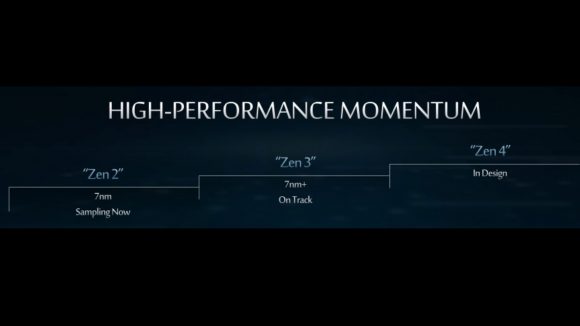November 6, 2018 AMD did indeed announce fresh details about it’s upcoming Zen 2 processor design, including doubling the core density and using a “revolutionary chiplet design” which mixes both 7nm and 14nm silicon.
AMD’s Next Horizon event happened today, introducing the world to the new AMD Zen 2 chiplet design. Today’s introduction was about how Zen 2 will impact the datacentre, but the architecture will surely impact the desktop design too.
The AMD Investor Relations page has links to the slides covering the new announcements today, showing the doubling of core densities, as well as the unique new chiplet design, mixing and matching the 7nm and 14nm production processes.
The whole Next Horizon event was about the datacentre and the new 7nm node, covering both the server CPU side with the new Rome processors, as well as the new 7nm Vega GPUs. During its Q3 earnings call a few weeks ago, Lisa Su had confirmed that the event would “discuss innovation of AMD products and technologies specifically designed for the datacentre on industry-leading 7nm process technology.”
AMD also announced that its Zen momentum was continuing, pointing to the Zen 3 designs being ‘on track’ and that the leap-frogging engineering teams also had the Zen 4 chip architecture ‘in design.’
There was, however, no news re. the RX 590. Ostensibly it’s a 12nm refresh of the RX 580, this card looks to offer roughly 10-15% improvement on the Polaris flagship’s performance in leaked benchmarks. However, AMD will likely make a very big fuss about this card once it’s prepared to dish out the details.
Datacentre and machine learning applications have been leading the charge for AMD’s next process node change, and took centre stage at the event. AMD has been making big waves in the datacentre world with its EPYC processors, seemingly helped along by Intel’s shortages, and also is making a concerted push into machine learning with its Vega Instinct graphics card, built on the 7nm Vega 20 GPU.
AMD is shifting almost the entirety of its production to the 7nm process node in the near-future, starting with the Vega 20 GPU. The move is propelled by advances AMD’s foundry partner TSMC has made with squeezing even more transistors into teeny tiny chips, lending to an increase in efficiency and performance.
The specs and performance of AMD’s Zen 2 microarchitecture have been kept away from prying eyes for the most part, with only a few glimpses of what’s to come in the public eye. Aside from the expected improvements brought on by the 7nm node, AMD has promised to continue support for the current AM4 socket until 2020, ostensibly confirming backwards compatibility across at least two generations of Zen architectures.
AMD’s next-gen chips will be continuing the fight against Intel’s 9th Gen Core processors, including the i9 9900K and i7 9700K. They will likely be first to take on any chips Intel can salvage from its heavily delayed 10nm process node, too. AMD will be hoping the performance/efficiency gains of the 7nm node will be able to give it the edge over Chipzilla going into 2020 and beyond.

